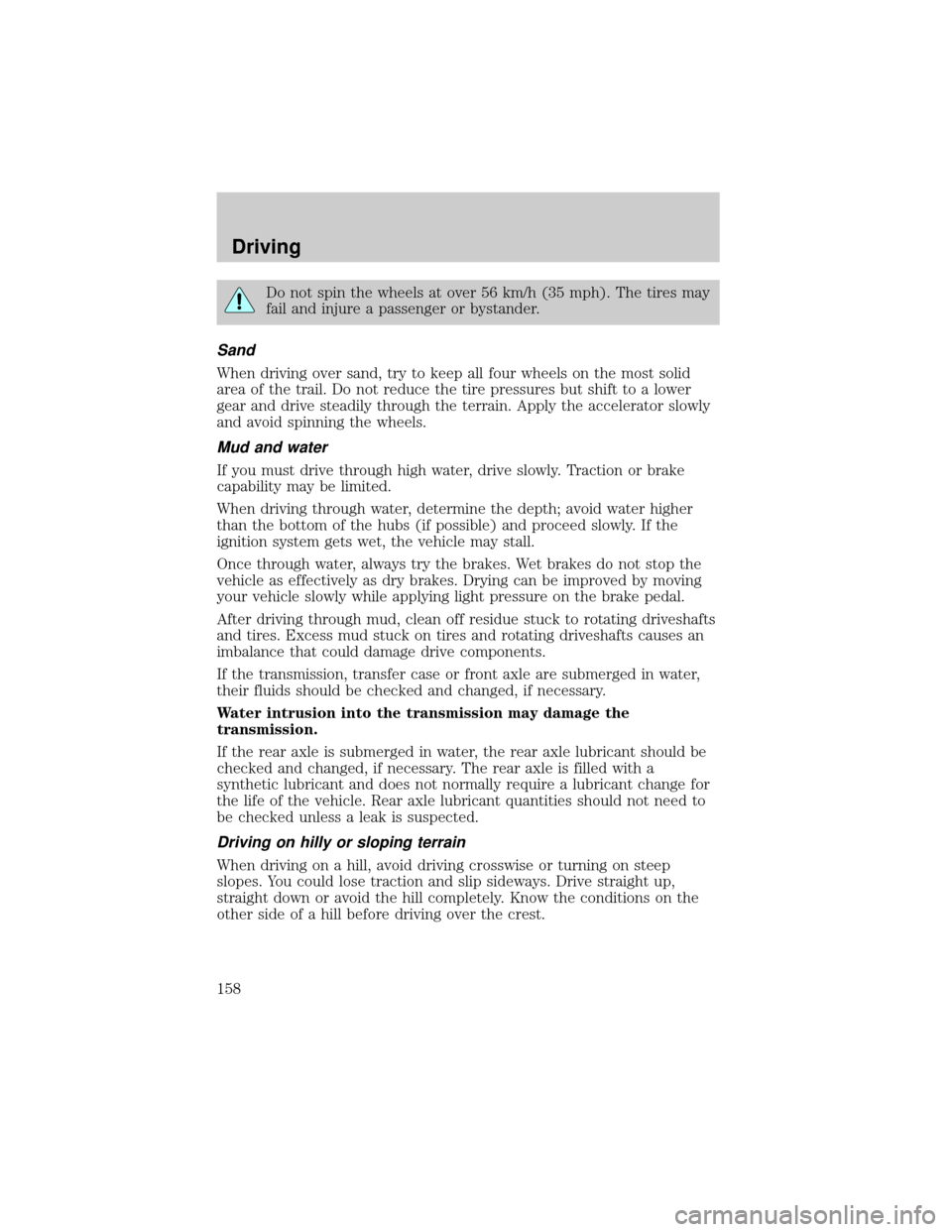check transmission fluid Mercury Mountaineer 2000 Owner's Manuals
[x] Cancel search | Manufacturer: MERCURY, Model Year: 2000, Model line: Mountaineer, Model: Mercury Mountaineer 2000Pages: 264, PDF Size: 2.29 MB
Page 158 of 264

Do not spin the wheels at over 56 km/h (35 mph). The tires may
fail and injure a passenger or bystander.
Sand
When driving over sand, try to keep all four wheels on the most solid
area of the trail. Do not reduce the tire pressures but shift to a lower
gear and drive steadily through the terrain. Apply the accelerator slowly
and avoid spinning the wheels.
Mud and water
If you must drive through high water, drive slowly. Traction or brake
capability may be limited.
When driving through water, determine the depth; avoid water higher
than the bottom of the hubs (if possible) and proceed slowly. If the
ignition system gets wet, the vehicle may stall.
Once through water, always try the brakes. Wet brakes do not stop the
vehicle as effectively as dry brakes. Drying can be improved by moving
your vehicle slowly while applying light pressure on the brake pedal.
After driving through mud, clean off residue stuck to rotating driveshafts
and tires. Excess mud stuck on tires and rotating driveshafts causes an
imbalance that could damage drive components.
If the transmission, transfer case or front axle are submerged in water,
their fluids should be checked and changed, if necessary.
Water intrusion into the transmission may damage the
transmission.
If the rear axle is submerged in water, the rear axle lubricant should be
checked and changed, if necessary. The rear axle is filled with a
synthetic lubricant and does not normally require a lubricant change for
the life of the vehicle. Rear axle lubricant quantities should not need to
be checked unless a leak is suspected.
Driving on hilly or sloping terrain
When driving on a hill, avoid driving crosswise or turning on steep
slopes. You could lose traction and slip sideways. Drive straight up,
straight down or avoid the hill completely. Know the conditions on the
other side of a hill before driving over the crest.
Driving
158
Page 161 of 264

gear and drive steadily through the terrain. Apply the accelerator slowly
and avoid spinning the wheels.
Mud and water
If you must drive through high water, drive slowly. Traction or brake
capability may be limited.
When driving through water, determine the depth; avoid water higher
than the bottom of the hubs (if possible) and proceed slowly. If the
ignition system gets wet, the vehicle may stall.
Once through water, always try the brakes. Wet brakes do not stop the
vehicle as effectively as dry brakes. Drying can be improved by moving
your vehicle slowly while applying light pressure on the brake pedal.
After driving through mud, clean off residue stuck to rotating driveshafts,
halfshafts and tires. Excess mud stuck on tires and rotating driveshafts
causes an imbalance that could damage drive components.
If the transmission, transfer case or front axle are submerged in water,
their fluids should be checked and changed, if necessary.
Water intrusion into the transmission may damage the
transmission.
If the rear axle is submerged in water, the rear axle lubricant should be
checked and changed, if necessary. The rear axle is filled with a
synthetic lubricant and does not normally require a lubricant change for
the life of the vehicle. Rear axle lubricant quantities should not need to
be checked unless a leak is suspected.
Driving on hilly or sloping terrain
When driving on a hill, avoid driving crosswise or turning on steep
slopes. You could lose traction and slip sideways. Drive straight up,
straight down or avoid the hill completely. Know the conditions on the
other side of a hill before driving over the crest.
When climbing a steep hill, start in a lower gear rather than downshifting
to a lower gear from a higher gear once the ascent has started. This
reduces strain on the engine and the possibility of stalling.
When descending a steep hill, avoid sudden braking. Shift to a lower gear
when added engine braking is desired.
When speed control is on and you are driving uphill, your vehicle speed
may drop considerably, especially if you are carrying a heavy load.
Driving
161
Page 195 of 264

5.0L V8 engine
1. Engine coolant reservoir
2. Windshield washer fluid reservoir
3. Engine oil filler cap
4. Automatic transmission fluid dipstick
5. Brake fluid reservoir
6. Power distribution box
7. Battery
8. Power steering fluid reservoir
9. Engine oil dipstick
10. Air filter assembly
ENGINE OIL
Checking the engine oil
Refer to the Scheduled Maintenance Guide for the appropriate intervals
for checking the engine oil.
1. Make sure the vehicle is on level ground.
2. Turn the engine off and wait a few minutes for the oil to drain into the
oil pan.
1
23
7
564
9810
Maintenance and care
195
Page 206 of 264

6. If the fluid is low, add fluid in small amounts, continuously checking
the level until it reaches the correct operating range. Be sure to put the
cap back on the reservoir.
TRANSMISSION FLUID
Checking automatic transmission fluid
Refer to your Scheduled Maintenance Guide for scheduled intervals for
fluid checks and changes. Your transmission does not consume fluid.
However, the fluid level should be checked if the transmission is not
working properly, i.e., if the transmission slips or shifts slowly or if you
notice some sign of fluid leakage.
Automatic transmission fluid expands when warmed. To obtain an
accurate fluid check, drive the vehicle until it is at normal operating
temperature (approximately 30 km [20 miles]). If your vehicle has been
operated for an extended period at high speeds, in city traffic during hot
weather or pulling a trailer, the vehicle should be turned off for about 30
minutes to allow fluid to cool before checking.
1. Drive the vehicle 30 km (20 miles) or until it reaches normal operating
temperature.
2. Park the vehicle on a level surface and engage the parking brake.
3. With the parking brake engaged and your foot on the brake pedal,
start the engine and move the gearshift lever through all of the gear
ranges. Allow sufficient time for each gear to engage.
4. Latch the gearshift lever in P (Park) and leave the engine running.
5. Remove the dipstick, wiping it clean with a clean, dry lint free rag. If
necessary, refer toIdentifying components in the engine compartment
in this chapter for the location of the dipstick.
6. Install the dipstick making sure it is fully seated in the filler tube.
7. Remove the dipstick and inspect the fluid level. The fluid should be in
the designated area for normal operating temperature or ambient
temperature.
Maintenance and care
206
Page 207 of 264

Low fluid level
Do not drive the vehicle if the fluid
level is at the bottom of the dipstick
and the ambient temperature is
above 10ÉC (50ÉF).
Correct fluid level
The transmission fluid should be checked at normal operating
temperature 66ÉC-77ÉC (150ÉF-170ÉF) on a level surface. The normal
operating temperature can be reached after approximately 30 km (20
miles) of driving.
You can check the fluid without driving if the ambient temperature is
above 10ÉC (50ÉF). However, if fluid is added at this time, an overfill
condition could result when the vehicle reaches normal operating
temperature.
The transmission fluid should be in
this range if at normal operating
temperature (66ÉC-77ÉC
[150ÉF-170ÉF]).
The transmission fluid should be in
this range if at ambient temperature
(10ÉC-35ÉC [50ÉF-95ÉF]).
ADD COLD HOT DO NOT ADD
ADD COLD HOT DO NOT ADD
ADD COLD HOT DO NOT ADD
Maintenance and care
207
Page 239 of 264

1Ensure the correct automatic transmission fluid is used. Transmission
fluid requirements are indicated on the dipstick or on the dipstick
handle. MERCONtand MERCONtV are not interchangeable. DO NOT
mix MERCONtand MERCONtV. Refer to your Scheduled Maintenance
Guide to determine the correct service interval.
2Indicates only approximate dry-fill capacity. Some applications may
vary based on cooler size and if equipped with an in-tank cooler. The
amount of transmission fluid and fluid level should be set by the
indication on the dipstick's normal operating range.
3Use Ford Premium Engine Coolant (green in color). DO NOT USE Ford
Extended Life Engine Coolant (orange in color). Refer toAdding engine
coolant, in the Maintenance and Care chapter.
4Fill to 6 mm to 14 mm (1/4 inch to 9/16 inch) below bottom of fill hole.
5Vehicles equipped with a 4.0L SOHC V6 engine may be equipped with a
conventional rear axle. Refer to your Scheduled Maintenance Guide for
axle fluid change intervals.
6Vehicles equipped with 4.0L SOHC V6 engine and 3.73:1 or 4.10:1 rear
axle ratios or with a 5.0L V8 engine require synthetic rear axle lubricant.
Rear axles containing synthetic lubricant are lubricated for life. These
lubricants are not to be checked or changed unless a leak is suspected or
service is required. The axle lubricant should be changed any time the
axle has been submerged in water.
Add 118 ml (4 oz.) of Additive Friction Modifier C8AZ-19B546-A or
equivalent meeting Ford specification EST-M2C118±A for complete refill
of Traction-Lok axles.
Capacities and specifications
239
Page 258 of 264

Air bag supplemental
restraint system .................126,130
and child safety seats ............128
description .......................126,130
disposal ....................................133
driver air bag ...................128,131
indicator light ...............9,130,132
operation ..........................128,131
passenger air bag ............128,131
side air bag ..............................130
Air cleaner filter .......................237
Air conditioning ..........................22
automatic temperature
control system ..........................25
rear seat controls .....................31
Air suspension ...........................147
description ..............................147
warning light .............................12
All Wheel Drive (AWD),
driving off road .........................159
Ambulance packages ....................3
Antifreeze
(see Engine coolant) ................200
Anti-lock brake system
(see Brakes) .......................144,145
Anti-theft system
warning light .............................11
Armrests ......................................99
Audio system (see Radio) .........35
Automatic transmission
driving an automatic
overdrive ..........................149,152
fluid, adding ............................206
fluid, checking ........................206
fluid, refill capacities ..............237
fluid, specification ..................242
Auxiliary power point .................98
Axle
lubricant specifications ...240,242
refill capacities ........................237
traction lok ..............................162
Battery .......................................210acid, treating emergencies .....210
charging system
warning light .............................11
jumping a disabled battery ....185
maintenance-free ....................210
replacement, specifications ...237
servicing ..................................210
voltage gauge ............................16
Belt minder ...............................122
Brakes ........................................144
anti-lock ............................144,145
anti-lock brake system
(ABS) warning light ..........10,145
brake warning light ..................10
fluid, checking and adding ....199
fluid, refill capacities ..............237
fluid, specifications ..........240,242
lubricant specifications ...240,242
parking ....................................145
shift interlock ..........................148
Break-in period .............................3
Capacities for refilling fluids ....237
Cargo area shade ......................100
Cargo cover ...............................100
CD changer .................................71
Certification Label ....................244
Child safety restraints ..............134
child safety belts ....................134
Child safety seats ......................135
in front seat ............................136
in rear seat ..............................136
tether anchorage hardware ...139
Cleaning your vehicle ...............231
engine compartment ..............232
exterior .............................232,234
exterior lamps .........................234
instrument panel ....................235
instrument panel lens ............235
interior ..............................234,235
mirrors .....................................236
plastic parts ............................234
safety belts ..............................235
Index
258
Page 259 of 264

washing ....................................231
waxing .....................................232
wheels ......................................233
windows ..................................236
wiper blades ............................234
woodtone trim ........................236
Climate control (see Air
conditioning or Heating) ............22
Clock ..................................41,51,64
Compass, electronic ....................86
calibration .................................88
set zone adjustment .................87
Console ........................................97
overhead ...............................83,84
rear ............................................98
Controls
power seat ...............................113
steering column ........................82
Coolant
checking and adding ..............200
refill capacities .................204,237
specifications ...................240,242
Cruise control
(see Speed control) ....................77
Customer Assistance ................171
Ford accessories
for your vehicle ......................252
Ford Extended
Service Plan ............................245
Getting assistance outside
the U.S. and Canada ..............251
Getting roadside assistance ...171
Getting the
service you need ....................245
Ordering additional
owner's literature ...................256
The Dispute
Settlement Board ...................248
Utilizing the Mediation/
Arbitration Program ...............251
Daytime running lamps
(see Lamps) ................................21Defrost
rear window ..............................33
Dipstick
automatic
transmission fluid ...................206
engine oil .................................195
Doors
door ajar warning .....................12
lubricant specifications ..........240
Driveline universal joint
and slip yoke .............................209
Driving under special
conditions ...........................158,161
mud .....................157,158,160,161
sand ..................................158,160
snow and ice ......157,159,160,162
through water ...........158,161,165
Emergencies, roadside
jump-starting ..........................185
Emission control system ..........224
Engine ........................................242
check engine/service engine
soon light ....................................8
cleaning ...................................232
coolant .....................................200
idle speed control ...................210
lubrication
specifications ...................240,242
refill capacities ........................237
service points ...................194,195
starting after a collision .........172
Engine block heater .................142
Engine oil ..................................195
checking and adding ..............195
dipstick ....................................195
filter, specifications .........198,237
recommendations ...................198
refill capacities ........................237
specifications ...................240,242
Exhaust fumes ..........................143
Floor mats ...................................99
Fluid capacities .........................237
Index
259
Page 262 of 264

Relays ........................................174
Remote entry system ........101,102
illuminated entry ....................105
locking/unlocking doors .........102
panic alarm .............................102
replacement/additional
transmitters .............................104
replacing the batteries ...........104
Reverse sensing system .............33
Roof rack ...................................170
Safety belts (see Safety
restraints) ......................13,116,117
118,119,120,121
Safety defects, reporting ..........257
Safety restraints .................116,117
118,119,120,121
belt minder .............................122
cleaning the
safety belts .......................125,235
extension assembly ................121
for adults ............117,118,119,120
for children ......................133,134
warning light
and chime ...............10,13,121,122
Safety seats for children ..........135
Seat belts
(see Safety restraints) .............116
Seats ..........................................112
child safety seats ....................135
cleaning ............................234,236
memory seat ...........................103
SecuriLock passive
anti-theft system ................109,110
Servicing your vehicle ..............192
Snowplowing .................................3
Spark plugs,
specifications ......................237,242
Special notice ................................3
ambulance conversions ..............3
utility-type vehicles ....................3
Specification chart,
lubricants ............................240,242Speed control ..............................77
Speedometer ...............................14
Starting your vehicle .........140,142
jump starting ..........................185
Steering wheel
controls ......................................82
tilting .........................................81
Tachometer .................................15
Tilt steering wheel ......................81
Tires .............................180,213,214
changing ....................180,181,182
checking the pressure ............214
replacing ..................................215
rotating ....................................214
snow tires and chains ............216
tire grades ...............................214
treadwear ................................213
Towing ................................165,214
recreational towing .................170
trailer towing ..........................165
wrecker ....................................191
Traction-lok rear axle ...............162
Transfer case
fluid checking .........................209
Transmission .............................148
fluid, checking and adding
(automatic) .............................206
fluid, refill capacities ..............237
lubricant specifications ...240,242
Trip odometer .............................15
Turn signal .............................10,76
Vehicle dimensions ...................242
Vehicle Identification Number
(VIN) ..........................................244
Vehicle loading ..........................162
Ventilating your vehicle ...........143
Warning chimes ...........................13
Warning lights (see Lights) .........8
Washer fluid ..............................200
Water, Driving through .............165
Windows
power .........................................94
Index
262